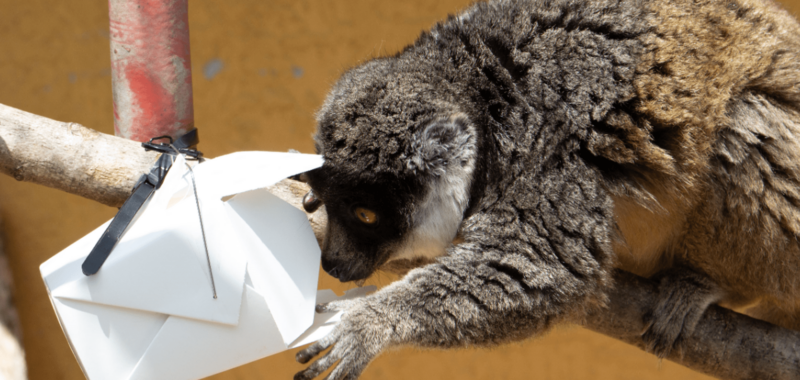While elephants have the reputation as animals who never forget, they may have some competition from some primates. Lemurs use their long-term memory in combination with smell and social cues to find hidden fruit. This technique may have deep evolutionary roots, according to a study published in the International Journal of Primatology.
“Our study provides evidence that lemurs can integrate sensory information with ecological and social knowledge, which demonstrates their ability to consider multiple aspects of a problem,” study co-author and New York University anthropologist Elena Cunningham said in a statement. Cunningham is a clinical professor of molecular pathobiology at NYU College of Dentistry.
[Related: Critically endangered lemur attacked by vulnerable fosa in Madagascar.]
Animals that forage typically rely on their senses, social knowledge, and environmental cues to locate food and water. These factors–potentially working together–are believed to be one reason that primates evolved to have higher cognitive abilities and larger brains than some other animals.
“Historically, there have been two schools of thought on why primates developed bigger brains: ecological pressures, such as needing to find scarce fruit in the forest, and the social pressures of living in a group where everyone is trying to outsmart one another,” said Cunningham. “I have long been interested in the interplay between social and ecological factors when it comes to cognition—it seems like a given that these would have evolved in relation to each other.”
In the new study, the team observed a group of lemurs at the Lemur Conservation Foundation in Myakka City, Florida. This reserve is dedicated to researching and protecting lemurs outside of their native homes in Madagascar. It is home to multiple lemur species, including brown lemurs (Eulemur fulvus). These social primates are considered vulnerable on the IUCN’s Red List, mostly eat fruit and have a keen sense of smell that is much better than ours.

The team designed an experiment using brown lemurs in pairs and groups of three. They hid pieces of cantaloupe in cardboard takeout containers and left fruit-filled and empty containers throughout the lemurs’ environment. Next, they observed how groups of lemurs investigated and opened the containers, while noting their interactions.
While the empty containers outnumbered the ones filled up with cantaloupe, the lemurs had very little trouble finding and subsequently munching on the fruit. Several factors appeared to be working together. The lemurs quickly learned which containers had fruit, and could remember where these treat containers were days, weeks, and even months later. The order in which they approached the containers was roughly 50 percent better than chance. However, the lemurs almost always (98 percent of the time) opened up the containers with fruit first, suggesting that they had smelled the cantaloupe at close range.
[Related: These fuzzy lemurs have a human-like ability to sing on beat.]
The team also observed that the lemurs’ individual strategies for finding fruit were influenced by social factors. Some of the groups were more egalitarian, with information about the cantaloupe willingly shared amongst the lemurs. Others tended to be more hierarchical. When dominant lemurs found fruit, they took advantage of their subordinates and ate the fruit solo. However, the subordinates were the ones more likely to find the fruit. Some of these underlings then used a “finder’s advantage” to gobble up more of the melon.
“What our study shows is that these three factors are all operating at the same time—the lemurs have memories of where the food is and they are considering olfactory information and social factors,” said Cunningham. “We still have much to learn about how this interplay and the evolution of cognition, but it’s important to look at these factors not in isolation, but in conversation.”

